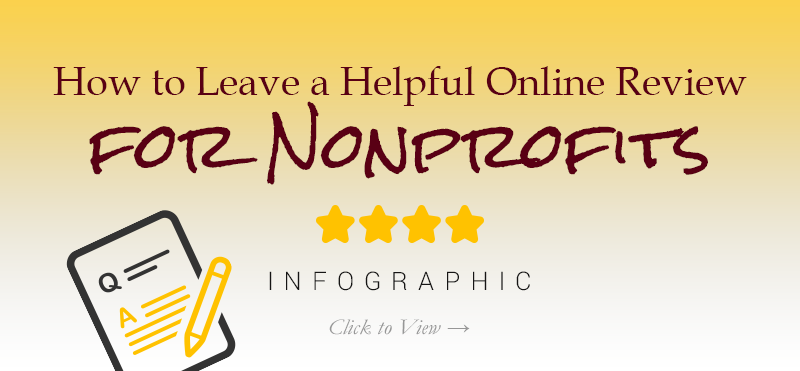
If so, you’re in good company: Some 90 percent of people make decisions based on online reviews, while 74 percent of people say they trust online reviews as much as personal recommendations. While brands have always had to manage their reputation, the first impression many customers have with a product these days is their reviews on Amazon, Facebook and more.

People want to know about your cause, mission and impact before donating. As a result, testimonials and ratings from an objective third party can be more influential than the impressive stats you might post on your own site.
Positive reviews can change visitors into lifelong donors.
Negative reviews can turn them into missed opportunities.
Have you looked at your online reviews lately? If so, do those reviews improve your credibility…or raise red flags?
In today’s post we’ll look at 6 strategies for nonprofits to attract online reviews that leave a great first impression. We’ll also provide a handy “Guide to Online Reviews” graphic to share with supporters that makes reviewing a breeze.
Step 1. Do work that merits positive reviews.
Don’t worry: This is the easy part!
The rest of this post is based on the assumption your organization is already doing work worthy of outstanding reviews. Here at Winspire, we have the pleasure of working with thousands of nonprofit clients, auctioneers, vendors and more to help raise more money for good causes.
As a Winspire News reader, I’m confident your impact deserves to be shared on social media.
Step 2: Create and claim profiles on multiple review sites
Reviews are a numbers game. The more positive reviews you get, the less weight a negative review holds.
It used to be that nonprofit rating sites like Charity Navigator led the way for these objective reviews. Organizations were evaluated based on criteria like financial health, transparency and overhead. While the process wasn’t necessarily comprehensive, it gave donors some reassurance before deciding to give.
Today the first search results that pop up for your organization are social media pages (like Facebook and Google) and directory sites (like Yelp, Glassdoor, Yellow Pages, and GreatNonprofits.org).
On social networks, you create your own profile and begin engaging followers.
Directory sites, on the other hand, may have information or a profile already set up on your organization. You’ll want to check the information for accuracy (for example, verifying your contact information) and claim your business to edit or add details.
(A note on GreatNonprofits.org: It’s the burgeoning “Yelp for Nonprofits”…check out these top-rated nonprofits that have collected hundreds or even 1,000+ personal stories from volunteers, donors and staff!)
Step 3. Provide guidelines for a review (see our handy graphic below).
The easier you can make leaving a review, the more likely you are to get reviews. It’s that simple!
In each request for reviews, provide guidelines or suggestions for a helpful review. You can share this handy graphic detailing the most popular sites and basic review etiquette:
Along with the guide, be sure to include direct links to your Facebook page, Google+ profile, LinkedIn page, GreatCharities.org site and more.
Note that we didn’t focus on getting glowing reviews. Reviews with constructive criticism or legitimate concerns reveal places you can improve, programs you can implement, or holes in your nonprofit’s story that could be told with more clarity.
So you don’t want to simply provide a script for donors to copy and paste. Not only will this trigger red flags for spam, but disingenuous and scripted reviews are easy to spot…diminishing the credibility of your organization far more than a lone negative review.
Step 4: Ask for reviews via email and social media.

Start by culling your email database for reviews. You can send out an email blast focused solely on review collection, then leave a small ongoing “call to action” button in your newsletters inviting supporters to review your nonprofit.
For best results, segment your database based on an important characteristic (like length of time involved with your nonprofit or role in the organization). Then you can tweak the messaging in your call for reviews for each different segment.
For example, if the email is going out to volunteers, ask them to specifically leave feedback on your most recent charity gala or auction. If the segment is new donors, ask them to comment on what made them support your cause and how their experience has been so far.
{{cta(‘0d350941-6089-4be9-9c57-ec4ab09838a8′,’justifycenter’)}}
The more you can fine-tune messaging, the more likely they are to respond.
{{cta(‘661274c0-1d2e-4806-a547-596f67dbe59d’,’justifycenter’)}}
Step 5: Address negative reviews quickly and professionally.

It’s likely you’ll get a negative review or low star rating sometime…and behind the safety of a keyboard, criticism can go from helpful to destructive in a second. What matters is how you handle it.
Address each negative review quickly (not rashly), professionally (with kindness), and privately (then mentioning the resolution in a response).
Here’s a few sample review setbacks and how you might respond…
Situation: Unhappy bidder
It’s been six months since the annual charity auction. Someone bid $2,000 on 5 nights in a board member’s vacation home…only to be told the home is undergoing renovations for the rest of the year.
Your response: Hopefully you have already reached out offline to apologize and explain the situation. This was a serious oversight and you understand the importance of providing items exactly as promised. However, if a winning bidder still felt the need to leave a comment online, the issue has not yet been resolved.
Respond publicly only after you’ve made every attempt to resolve the issue. Again apologize for the inconvenience. Thank her for her support and mention the solutions you had suggested offline. Finally, consider partnering with a travel provider like Winspire to avoid big-ticket travel items falling through at the last minute. (Click here to view our Top 10 bestselling trips, which can be used in your event with no upfront cost.)
Situation: Shunted volunteer
A volunteer at your annual 5K reports feeling overworked, mistreated or ignored after last week’s event.
Your response: Volunteers make events go ’round, but they may not all have personal connections to your cause, or the same expectations for an event.
In a reply, thank them for donating their priceless time and bringing the issue to your attention. Apologize for the incident and make sure someone from the organization, like your volunteer coordinator, reaches out personally. Assure them that their feedback is highly valued, then mention 1 or 2 things you’ll implement in the future to make the process smoother for all.
Situation: Misinformed donor
A donor or supporter heard that funds from last year’s annual campaign were routed toward administration fees and programs not vital to the nonprofit’s mission.
Your response: This is a serious accusation, but there’s no need to get defensive or emotional. Stick to the facts. The commenter likely does not have a complete picture of the many programs and moving parts required to fulfill your mission.
Thank them for their concern and explain where they have been misinformed. Explain any procedures you have for transparency. Encourage them to reach out to your nonprofit directly with any additional concerns.
Bottom line: Reviewers know how important reviews are to charities that rely on donations. Oftentimes, they will go back and update their review once their issue has been adequately addressed. If they don’t, state your case in a reply comment, and leave it at that. You don’t want to start a “comment war” or engage in a hostile, public discussion.
Step 6. Stay engaged with supporters.
We all know donors are busy people. For some, being asked to post a review more than once may be a nuisance. Instead, simply engaging them online is a safe way to get reviews organically.
Today people are used to posting online about every experience. Stay engaged with supporters, and they’ll know exactly where to leave a review when they do have a noteworthy experience with your organization.
Your turn – If you learned something about social media reviews today, give Winspire a shoutout on our Facebook page! Like you, we would so appreciate any feedback you can give. You might comment on…
- Which resources you’ve found helpful and why (blog, templates, webinars)
- Your experience working with a Fundraising Specialist
- How Winspire’s no-risk travel items have improved your fundraising results
- Your Winning Bidders’ experiences redeeming trips
- Areas of potential improvement
….and more! Share any and everything that might help other nonprofits decide whether no-risk travel packages and/or Winspire News are right for their needs.
{{cta(‘b1ec3c07-bcc8-4d9a-a879-66796c2cd9d9′,’justifycenter’)}}


